Review of Seven Samurai - The Criterion Collection
Introduction
`Seven Samurai` (`Shichinin no samurai`) begins in 16th century Japan as 40 bandits are about to raid a village. The bandit leader points out that they robbed it last year and there will be nothing to take, so they should wait until the barley is ripe. Unbeknownst to them a villager was eavesdropping who takes the news back to the other farmers, to their utter dismay. They realise that they have no money to pay samurai to defend them, but one states that desperate samurai will work for food. The village elder authorises four men to go and look for four such samurai
They come to a village, where a child is being held hostage by a thief. Kambei (Takashi Shimura), a `ronin` (masterless samurai) kneels by the pond and cuts off his topknot - an important symbol of his identity - and goes on to shave his head, pretending to be a priest. He is thereby able to gain access to the where the child is being held and kills the villain. His job done, he wanders off accompanied by Katsushiro (Isao Kimura), who asks to be his disciple and Kikuchiyo (Toshirô Mifune), who claims he is a samurai, but Kambei laughs off his approach and walks off without him.
Asked by the villagers to help, Kambei deduces than they are open to attack from four sides and that six more samurai would be needed to defend them. When it is explained that the farmers live on millet and that they are prepared to provide samurai with white rice to eat, Kambei agrees to help and recruit other ronin like him. Over a period of days Gorobei, Heihatchi, Kyuzo, Shichiroji and finally Kikuchiyo join Kambei and head to the village, where they are gradually welcomed.
The timeline of the film is very clear: the bandits will attack after the harvest, so Kambei and the other samurai have until then to prepare for the raid. Meanwhile, they can make weapons and train the men to use them as best they can, build defences and send out scouting parties. During this time, Katsushiro and Shino (Keiko Tsushima) begin seeing each other in secret as her father has cut her hair and dressed her as a boy to prevent any sexual approaches by the samurai.
With the harvest complete, the showdown commences in a torrential downpour as the 13 remaining bandits attack during one of the most exciting action sequences ever filmed.
Criterion released a version of `Seven Samurai` in 1999, re-issuing it in 2006 with more extra features and improved video and sound quality; this review is of that version.
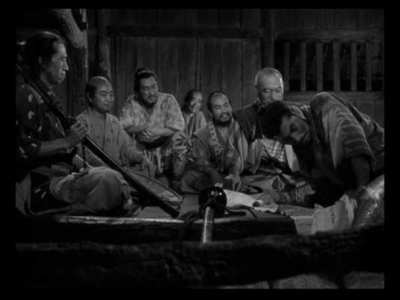
Video
Presented in the original aspect ratio 1.33:1, this restored, high-definition digital transfer looks superb, even when comparing it against the impressive BFI release. Kurosawa was a master of composition and his use of deep-focus is outstanding, showing action in the foreground, middle and background, allowing you to view each one with equal clarity.
I thought the BFI release looked good, but comparing a few screenshots reveals a startling difference in quality: gone are the instability, dirt, scratches and grain that I took for granted and the film looks stunning. There are a few remaining artefacts from the duplicate print that they used, but the contrast is deep and the focus is sharp. Spreading the film across two discs allows for the highest bitrate to be used and it shows - it`s worth visiting DVDBeaver.com to see the comparison between the first Criterion release, the BFI version and this, just to see how good this looks.
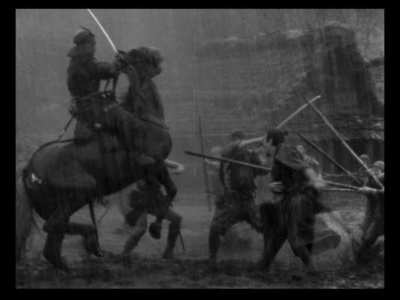
Audio
As well as the remastered Dolby Digital Japanese 1.0 mono is a new DD 4.0 mono mix. There isn`t much difference between the two, although the 4.0 is a deeper track, but strangely I preferred the original mono. The quality though is excellent for both, without any hiss, pops, clicks or crackles.
The score, composed by Fumio Hayasaka while he was dying of tuberculosis, is outstanding and the samurai theme that accompanies Kambei at the beginning and resurfaces at poignant moments, lingers long in the memory.
The optional English subtitles are excellent and apparently are faithfully translated from the Japanese.
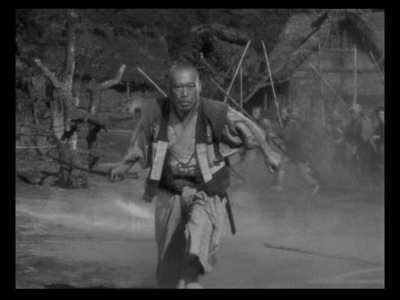
Features
The film is spread over discs one and two, with two audio commentaries, one by Japanese-film expert Michael Jeck and the other by film scholars David Desser, Joan Mellen, Stephen Prince, Tony Rayns, and Donald Richie. The Michael Jeck commentary is authoritative and interesting, showing why he is regarded amongst the foremost experts on Japanese film, although I preferred the `relay` nature of the `scholars` commentary, where each talks for around 40 minutes before handing over to the next speaker. They each have something different to offer without over-extending themselves and running out of things to say.
There are 3 theatrical trailers and a teaser trailer, with a `play all` function and a production gallery containing behind the scenes photos and posters.
In addition to Part II of the film, disc two also contains a 50 minute `making of` documentary, created as part of the Toho Masterworks series `Akira Kurosawa: It is Wonderful to Create`. This is a fascinating look at the writing process behind `Seven Samurai` and gives a real insight into how the film came to be.
Disc three contains two documentaries, `My Life in Cinema`, a conversation between Akira Kurosawa and Nagisa Oshima (115:51) and `Seven Samurai: Origins and Influences` (55:06). If you are a fan of Kurosawa`s and want to know more about him, his upbringing and how he became a leading director at Toho studios, then you`ll find this fascinating. He`s not the most effusive of speakers - a similar interview with Martin Scorsese would be very different - so Oshima does a great job of keeping the thing moving and coaxing the answers from Kurosawa as he smokes his way through the interview. The `Origins and Influences` documentary tells you how the film came about, its impact on the then dead samurai genre of films and the cultural significance of the samurai.
Completing the package is a 56-page booklet with essays by Peter Cowie, Philip Kemp, Peggy Chiao, Alain Silver, Kenneth Turan, Stuart Galbraith, Arthur Penn, and Sidney Lumet and an interview with Toshiro Mifune. These are all excellent reads, with different takes and approaches to the film. It would be worth buying on its own, so to have this come with the DVD is fantastic.
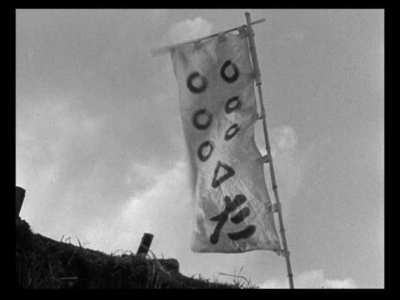
Conclusion
Regarded as one of the great films by one of the great directors, Akira Kurosawa`s `Seven Samurai` (`Shichinin no samurai`) has a story that is both simple, yet full of complexities. The basic premise belies the philosophical, emotional, sociological and historical aspects of the film.
Remade as `The Magnificent Seven` (just as `Yojimbo` was remade as `A Fistful of Dollars` and `Last Man Standing` and `Rashômon` remade as `The Outrage`), `Seven Samurai`, argues Michael Jeck, invented the `team mission` genre, where a disparate group of individuals join together to embark on a seemingly impossible task.
Just as short movies if they are very bad can feel as if they last an eternity, if a long film is very good, the time flies and this is the case with `Seven Samurai`. Split over two discs with an intermission, it never feels like the film is nearly three and a half hours long.
Kurosawa gathered a superb cast, chiefly Toshirô Mifune and Takashi Shimura, who he had previously worked with and would go on to collaborate with again. Mifune is an extraordinary screen presence, full of energy and an excellent swordsman as he would show again in `Yojimbo`, but his finest moment is the powerful and emotional speech where he berates the farmers for being cunning, sly and dishonest - revealing his own background in the process. In contrast to Mifune, Shimura`s measured Kambei is an experienced samurai, whose planning and execution of the village`s defence is methodical and thorough: he maps out the area, identifies vulnerable points and how best to defend them and keeps score of the bandits remaining. Each of the samurai and other main characters are so beautifully played and fully rounded, that you really care about their fate - you want the romance between Katsushiro and Shino to succeed even though you know it can never be with such a rigid caste system in place.
When it comes, the final attack is brilliantly orchestrated, with the rain and mud adding to the tremendous and meticulously planned fight sequence - an awesome spectacle even by today`s standards.
Akira Kurosawa left a body of work full of outstanding films, such as `Yojimbo`, `Rashômon` and `Ikiru`; where such a masterful cinematic achievement as `Seven Samurai` stands amongst them is hard to say. At 207 minutes, it is certainly the longest and probably the most demanding of his pictures, but also the most rewarding - the time spent with the characters and the emotional investment pays off at the end.
This is an excellent set that the film fully deserves and is worthy of your time and money even if you own one of the previous releases.
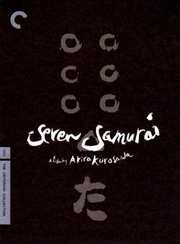
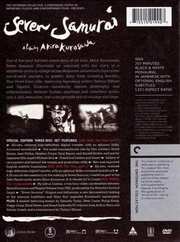
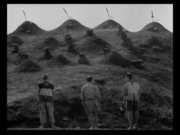

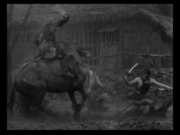
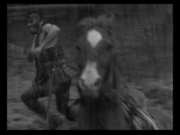


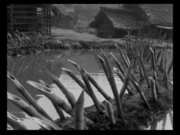
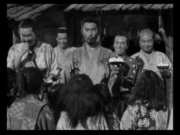
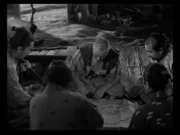

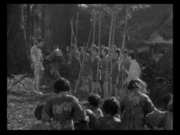

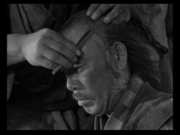
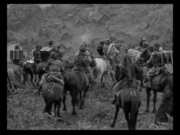
































Your Opinions and Comments
Be the first to post a comment!